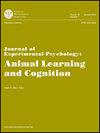鸽子的选择主要取决于信号的价值,而不是它的频率或对比度。
IF 0.9
4区 心理学
Q4 BEHAVIORAL SCIENCES
Journal of Experimental Psychology-Animal Learning and Cognition
Pub Date : 2022-04-01
DOI:10.1037/xan0000316
引用次数: 3
摘要
鸽子通常更喜欢20%的有信号的强化,而不是50%的没有信号的强化。甚至有证据表明,他们更喜欢50%的信号强化而不是100%的信号强化。有人认为,这种效应是由选择时预期强化概率(例如,50%)与强化积极信号值(100%)之间的对比造成的。或者,主要是强化本身的积极信号的值决定了次优选择。试图区分这两个假设,在实验1中,我们给鸽子(a) 50%的钢筋替代之间的选择,其次是两个信号之一100%强化,每25%的时间,或一个信号缺乏强化的50%的时间(50%对比)和(b)钢筋替代25%,紧随其后的是一个信号强化100% 25%的时间,或一个信号缺乏强化75%的时间(75%对比)。尽管对比不同,但鸽子对这两种选择无动于衷。在实验2中,当对比度保持在50%不变,强化正信号的值不同时,我们发现基于强化正信号的值支持选择。因此,鸽子的选择似乎主要取决于结果的价值,而不是其频率或对比。(PsycInfo Database Record (c) 2022 APA,版权所有)。本文章由计算机程序翻译,如有差异,请以英文原文为准。
Pigeon's choice depends primarily on the value of the signal for the outcome rather than its frequency or contrast.
Pigeons typically prefer a 20% probability of signaled reinforcement over a 50% probability of unsignaled reinforcement. There is even evidence that they prefer 50% signaled reinforcement over 100% reinforcement. It has been suggested that this effect results from contrast between the expected probability of reinforcement (e.g., 50%) at the time of choice and the value of the positive signal for reinforcement (100%). Alternatively, it is primarily the value of the positive signal for reinforcement itself that determines suboptimal choice. To attempt to distinguish between these two hypotheses, in Experiment 1, we gave pigeons a choice between (a) a 50% reinforcement alternative that was followed by one of two signals for 100% reinforcement, each 25% of the time, or a signal for the absence of reinforcement 50% of the time (50% contrast) and (b) a 25% reinforcement alternative that was followed by a signal for 100% reinforcement 25% of the time, or a signal for the absence of reinforcement 75% of the time (75% contrast). In spite of the difference in contrast, the pigeons were indifferent between the two alternatives. In Experiment 2, when contrast was held constant at 50% and the value of the positive signals for reinforcement were different, we found support for choice based on the value of the positive signal for reinforcement. Thus, it appears that pigeons' choice depends primarily on the value of the outcome rather than its frequency or contrast. (PsycInfo Database Record (c) 2022 APA, all rights reserved).
求助全文
通过发布文献求助,成功后即可免费获取论文全文。
去求助
来源期刊

Journal of Experimental Psychology-Animal Learning and Cognition
Psychology-Experimental and Cognitive Psychology
CiteScore
2.90
自引率
23.10%
发文量
39
期刊介绍:
The Journal of Experimental Psychology: Animal Learning and Cognition publishes experimental and theoretical studies concerning all aspects of animal behavior processes.
 求助内容:
求助内容: 应助结果提醒方式:
应助结果提醒方式:


